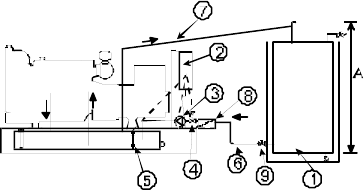
15
With this system, the basetank must include an
overflow via the return line, sealed fuel level gauges
and no manual fill facility. All other connections on
top of the tank must be sealed to prevent leakage.
Fuel System 2 is not compatible with the
polyethylene fuel tanks standard on smaller
generator sets. The optional metal tank is required.
A 2001 Series control system (or above) is required.
Distance ‘A’ in Figure 10.2 is limited to 1400mm for
all generator sets with metal basetanks.
Fuel System 4: Some installations may require a
system where fuel is pumped from a free standing
bulk tank (see Figure 10.4). This pumped system
would only be used if gravity feed is not possible
from the bulk tank to the basetank.
Figure 10.4:Typical Layout with Fuel System 4
The key components are the above ground bulk
fuel tank (item 1), remote fuel system controls (item
2) located in the generator set control panel, an AC
Fuel Pump (item 3), a DC motorised fuel valve (item
4), fuel level switches in the basetank (item 5), the
fuel supply line (item 6), an extended vent/return
line (continuous rise) on the basetank (item 7), a
fuel strainer (item 8) and an isolating valve at the
bulk tank (item 9).
When set to automatic, the system operates as
follows: low fuel level in the basetank is sensed by
the fuel level sensor. The DC motorised valve is
opened and the pump begins to pump fuel from the
bulk tank to the basetank through the supply line.
To help ensure that clean fuel reaches the engine,
fuel from the bulk tank is strained just prior to the
motorised valve. When the basetank is full, as
sensed by the fuel level sensor, the pump stops
and the motorised valve is closed. Any overflow
into the basetank or overpressure in the basetank
will flow back to the bulk tank via the extended
vent.
With this system, the basetank must include an
overflow via the return line, sealed fuel level gauges
and no manual fill facility. All other connections on
top of the tank must be sealed to prevent leakage.
Fuel System 4 is not compatible with the
polyethylene fuel tanks standard on smalle
generator sets. The optional metal tank is required.
A 2001 Series control system (or above) is required.
Distance ‘A’ on Figure 10.4 is limited to 1400mm for
all generator sets with metal basetanks. Note that
the maximum restriction caused by friction losses
and height of the return line should not exceed 2
psi.
10.3 Tank Construction
Fuel tanks are usually made of welded sheet steel or
reinforced plastic. If an old fuel tank is used, be
sure it is made of a proper material. It should be
cleaned thoroughly to remove all rust, scale and
foreign deposits.
Connections for fuel suction and return lines must
be separated as much as possible to prevent re-
circulation of hot fuel and to allow separation of
any gases entrained in the fuel. Fuel suction lines
should extend below the minimum fuel level in the
tank. Where practical, a low point in the tank
should be equipped with a drain valve or plug, in an
accessible location, to allow periodic removal of
water condensation and sediment. Or a hose may
be inserted through the tank's filter neck when
necessary to suck out water and sediment.
The filler neck of the bulk fuel tank should be
located in a clean accessible location. A removable
wire screen of approximately 1.6 mm (1/16 inch)
mesh should be placed in the filler neck to prevent
foreign material from
entering the tank. The filler neck cap or the highest
point in the tank should be vented to maintain
atmospheric pressure on the fuel and to provide
pressure relief in case a temperature rise causes the
fuel to expand. It will also prevent a vacuum as fuel
is consumed. The tank may be equipped with a fuel
level gauge - either a sight gauge or a remote
electrical gauge.
10.4 Fuel Lines
The fuel lines can be of any fuel compatible material
such as steel pipe or flexible hoses that will tolerate
environmental conditions.
Fuel delivery and return lines should be at least as
large as the fitting sizes on the engine, and overflow
piping should be one size larger. For longer runs of
piping or low ambient temperatures the size of these
lines should be increased to ensure adequate flow.


















